Detailed explanation of SOA semiconductor optical amplifier application examples:
cross-border innovation from optical fiber communication to quantum technology
Introduction
In the field of optical communication and photonics, SOA semiconductor optical amplifier (SOA) has become one of the core components of modern optical systems due to its miniaturization, high integration and wide bandwidth. This article will provide an in-depth analysis of the actual value of SOA through six application scenarios and discuss its future potential.
Quick overview of the basic principles of SOA
SOA is based on the principle of stimulated radiation amplification of semiconductor materials, and realizes the direct amplification of optical signals through current injection of activated gain media (such as InP/InGaAsP).
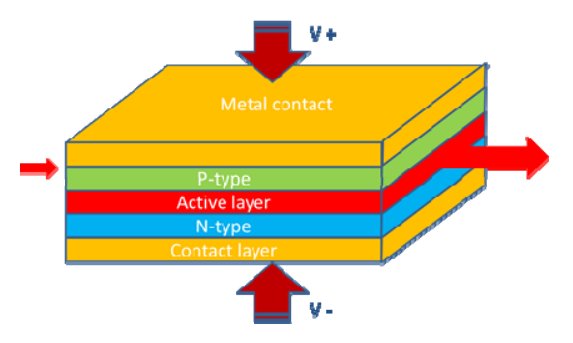
| 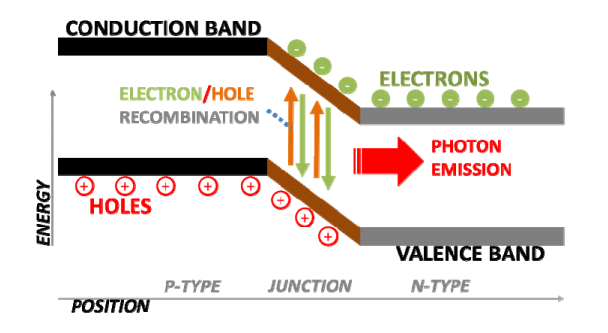
|
| The physical structure and energy level transitions of SOA |
Key Benefits:
· The volume is only 1/10 of the traditional EDFA (erbium-doped fiber amplifier).
· Supports wide range of gain from C-band to L-band (1530-1625nm).
· Can be integrated into photonic chips
Analysis of application examples
1.Optical fiber communication:Break through the limitation of relay distance
Pain points:In long-distance transmission of submarine optical cables,traditional EDFAs need to be deployed every 80km,which is costly.
SOA Solutions:
· As a preamplifier to improve the sensitivity of the receiver and extend the transmission distance without repeaters to 120km (case: a transoceanic optical cable project uses an SOA array to reduce the number of repeaters by 30%).
· Dynamic gain equalization: By adjusting the SOA drive current, the unbalanced loss of multi-wavelength signals can be compensated in real time
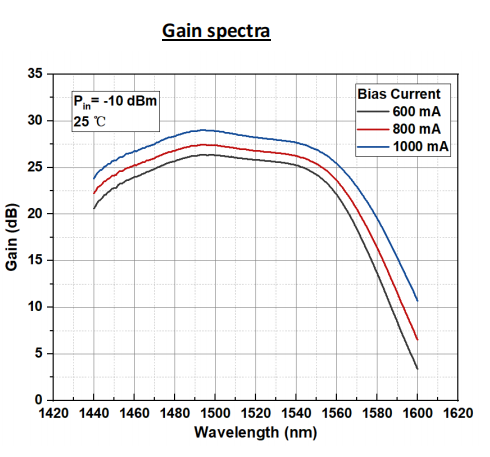
Current-dependent curve of the gain spectrum of a high-power SOA
2. Optical switching and wavelength conversion: the key enabler of all-optical networks
Experimental data: In wavelength conversion applications, SOA is based on the principle of cross-gain modulation (XGM), which can realize all-optical wavelength switching of 160Gbps signals with a power consumption of less than 1W.
Typical Cases:
· The optical interconnection system of a data center adopts the SOA+silicon optical waveguide scheme to reduce the optical switch response time from ms to ns.
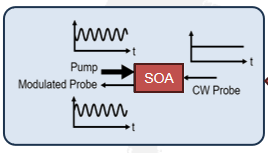
SOA is used for all-optical wavelength conversion
3. Fiber Optic Sensing: Dynamic modulation in optical sensing
Application scenario: In distributed optical fiber sensing (such as DAS and BOTDA), the parameters of the light source are modulated to enhance the signal.
Instance:
· In phase-sensitive OTDR(Φ-OTDR).The SOA modulates the pulse width and power to improve vibration detection sensitivity.
· Combined with pseudo-random code modulation, high dynamic range optical time domain reflectance measurement is realized through SOA.
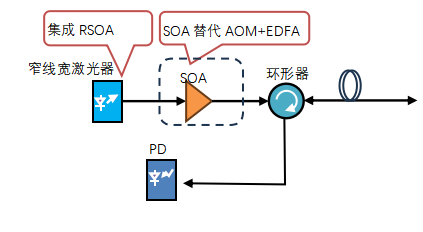
Use SOA as a chopper and amplifier to build a distributed fiber optic sensing system
4. LiDAR: The secret weapon of high-resolution detection
Technological Breakthroughs:
· Pulse compression: After the SOA amplifies the 1550nm laser pulse, it is compressed to the ps level through the chirped fiber grating to achieve centimeter-level spatial resolution
· Doppler velocimetry: In automotive LiDAR, SOA amplifies local oscillating light to improve the signal-to-noise ratio of weak echo signals.
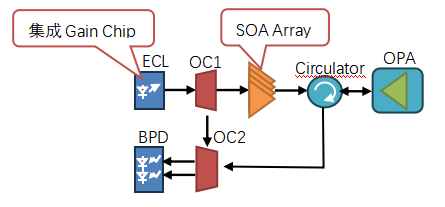
Block diagram of the FMCW LiDAR optical path
5. Quantum Communication: The Guardian of Single-Photon Signals
Cutting-edge applications:
· In the quantum key distribution (QKD) system, SOA, as a low-noise preamplifier, can maintain the <6dB noise index under the weak signal of -50dBm, which significantly improves the bit rate (experimental data: a quantum laboratory extends the transmission distance from 150km to 220km).
6. Biomedical Imaging: A "Light Microscope" That Penetrates Tissue
Innovation Cases:
· After the integration of SOA in the optical coherence tomography (OCT) system, the bandwidth of the light source is extended from 50 nm to 100 nm, and the axial resolution is increased to 3 μm
Challenges and future prospects
Existing Issues:
· Nonlinear effects at high power result in signal distortion
· Polarization correlation limits application in some scenarios
Technological breakthrough direction:
· Quantum dot SOA: The gain bandwidth is extended to more than 2μm, which is suitable for mid-infrared sensing
· Silicon-based hybrid integration: Compatible with CMOS process, reducing costs to 1/5 of existing solutions
Conclusion
From deep-sea fiber optic cables to autonomous driving, from quantum communication to early cancer diagnosis, SOA is driving multi-field changes as an "optical Swiss army knife". With the development of silicon photonics technology and new materials, its application boundaries will continue to expand and become the cornerstone of future infrastructure such as 6G and quantum Internet.
Related products: Click here